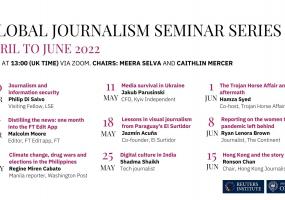How mobile phones are changing journalism practice in the 21st Century
04 Mar 2014
Rima Marrouch writes: Mobile phones are a crucial piece of equipment changing not only the way readers and viewers consume the news today but also sometimes the way the content is being produced. Mobile phone with a camera capacity is a product of the mid-1990s; video capacity came a few years later, according to Hadland. Today, there are around six billion phones around the world, many of them smart phones. There was a moment in the recent history of journalism when Mobile Journalism (also called Mojo) seemed to be the next big thing. The use of content recorded with a mobile phone kicked off with the Iraqi invasion in 2003. Footage shot on a mobile phone were also important during the Madrid bombings and in Tsunami coverage. The peak of this type of media production content came during the 2005 London bombing. As it took place underground, with difficult access for TV crews, a lot of footage that became available came from ordinary people's phones. "Within hours, the BBC had received a thousand photographs, 4,000 text messages and 20,000 emails from the public. There was a real expectation there that this piece of equipment would have a dramatic impact on journalism, broadcast and others," says Hadland quoting Richard Sambrook of the BBC as saying that "People were participating in our coverage in a way that we had never seen before. By the next day, our main evening TV newscast began with a package edited entirely from video sent in by viewers. From now on news coverage is a partnership." With news like Park Chan-wook, one of South Korea's top movie directors, shooting in 2011 a short film Paranmanjag (Eng.: Night Fishing) entirely on an iPhone and embracing the mobile technology, things seemed to be moving well. But at least in journalism it seems that everything did not go as expected. In Hadland's research on the use of mobile phones in the production in UK broadcasting (analyzing the content of news bulletins over six months of three UK-based broadcasters: Channel 4, BBC and ITV News) mobile-produced content was only a small part of the broadcast content of news bulletins (1% - 2%). According to Hadland, there are three types of Mobile Journalism: User Generated Content - raw unedited material sent by amateur eyewitnesses who happened to be there Citizen Journalists content – who manage to get their material to major broadcasters Professional Journalists who tell stories with video/audio using a mobile phone, who are able to shoot, edit and upload from the spot in real time (produce on the spot piece of work that is up loadable). There are many apps out there for both Android and iPhone: Tout, Mobile video publishing platform, FilmicPro (to shoot video on your iPhone allowing you to control exposure and white balance, etc.), Videon (allows you not only to record but also to edit), VideoPro Camera, iMovie, and for editing also Voddio Many media outlets like the BBC or CNN are encouraging especially UGC submission. Post-2005, BBC has established a whole UGC hub. The Wall Street Journals introduced in 2012 "Worldstream" with 400 reporters trained in smartphone video production. Newspapers around the world are embracing the growth of online video to engage their audience and expand their web presence. The focus is especially on videos as there is public enthusiasm for this medium. Millions of videos are viewed per day on YouTube, according to Hadland. There are many challenges with using mobile phones in reporting and production. The first challenge is getting the sound right. Any background noise is recorded so the reporter needs to stand really close to the person s/he is interviewing. With UGC is it often difficult and expensive to verify the content. According to Hadland, there are also difficulties in integrating different newsrooms to a unified system of production with so many different types of smartphones available. But it is a tool that is cost-effective. With a small, handy, and inexpensive kit you can quickly produce content. Especially when today, on average editorial staff are expected to produce three times as much content as their counterparts did 20 years ago. Holland says that he and his team of researchers were actually surprised how rare broadcasters are using this type of content. "It is being used in mainstream broadcasting quite sparsely. There are other areas like web broadcasting where it will be probably used much more and the potential is much greater. But it seems to me that it is really that it is Print/online journalism where it is growing fastest and most progress is being made. I think it is important and it will continue to be important,” he says. He added that Sambrook was perhaps premature in his enthusiasm for stating that things will never be the same. “Maybe there will be stories, for example the tsunami, that will be driven largely by this kind of content but I think it will be periodic." It seems though that journalists have not fully embraced producing mobile phone content. Many use mobile phones as a back up or to take audio notes. Some radio journalist use it also when they are in a field in difficult circumstances where you don’t want to trigger a lot of attention with a big shotgun mike or when you need to file a quick news a spot from a location of breaking news. It seems to me that news consumer do not mind if the quality of the video is poor on YouTube or social media. But when they turn to mainstream media outlets they expect high-quality products and aesthetics with good sound and image. Maybe this is also one of the reasons why Mobile Journalism has not become the next big thing as expected. Undoubtedly, it is a good back-up when your equipment fails.



